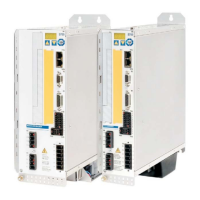5.4 LED display
A 3-character LED display indicates the status of the amplifier after switching on the 24V
supply (ð p.121). When the keys on the front panel are used, the parameter and function
numbers are shown, as well as the numbers for any errors and warnings that may occur
(ð p.122ff).
5.5 Grounding system
AGND — analog inputs, internal analog ground
DGND — 24V-IO, digital inputs and digital outputs, optically isolated.
GND — internal digital ground, encoder Emulation, RS232, CAN
XGND — 24V supply, STO Enable, ventilator, brake
5.6 Dynamic braking (brake circuit)
During braking with the aid of the motor, energy is fed back into the servo amplifier. This
generated energy is dissipated as heat in the brake resistor. The brake resistor is swit-
ched in by the brake circuit.
The setup software can be used to adapt the brake circuit (thresholds) according to the
electrical supply voltage.
Our customer service can help you with the calculation of the brake power that is neces-
sary for your system. A simple method
is described in the "Product Wiki" which is acces-
sible at www.wiki-kollmorgen.eu
. A description of the interface can be found on page 72.
Functional description:
1.- Individual amplifiers, not coupled through the DC bus link circuit (DC+, DC-)
When the energy fed back from the motor has an average or peak power that exceeds
the preset level for the brake power rating, then the servo amplifier generates the warning
“n02 brake power exceeded” and the brake circuit is switched off.
The next internal check of the DC bus link voltage (after a few milliseconds) detects an
overvoltage and the output stage is switched off, with the error message “Overvoltage
F02” (ð p.122).
The BTB/RTO contact (terminals X3B/14,15) will be opened at the same time (ð p.101)
2.- Several servo amplifiers coupled through the DC bus link (DC+, DC-)
Using the built-in brake circuit, several amplifiers of the same series can be operated off a
common DC bus link (observe page 70), without requiring any additional measures.
90% of the combined power of all amplifiers is always available for peak and continuous
power. The switch-off on overvoltage takes place as described under 1. (above) for the
amplifier that has the lowest switch-off threshold (resulting from tolerances).
Technical data of the brake circuits depend on the amplifiers type and the mains voltage
situation. See table on the next page.
S701x2-S724x2 Instructions Manual 33
Kollmorgen 07/2014 Technical description

